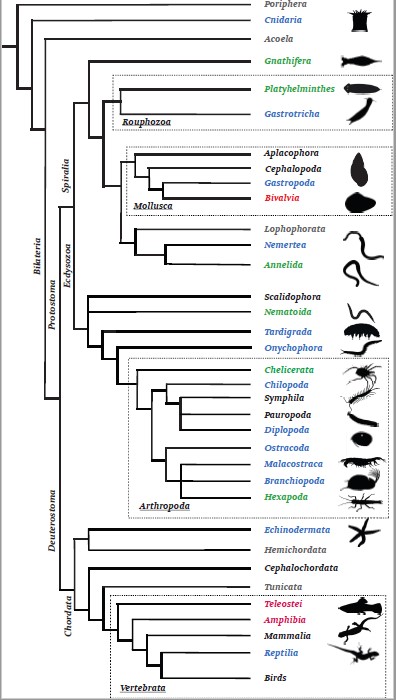Evolution of Asexuality in Hybrid Species
In collaboration with: Prof. Francisco Úbeda , Prof. Geoff Wild , Prof. Ingo Schlupp and Dr. Waldir Berbel-Filho
Table of contents
Sex or Asex? Two Strategies with Pros and Cons
Sexual Reproduction is the process by which two independently-produced gametes (in our case, spermatozoids and ova) fuse to
produce a new offspring. The two gametes may be produced by different individuals (in outcrossing organisms like Mammals), or by the same
individual (in self-fertilizing species, among which many plants but also some animals like some flat worms or snails). In
both cases, the resulting individual is different from the parent(s).
Sexual Reproduction is a complex process that involves: (1) the production of reduced gametes via meiosis, (2) mating behaviours
(outcrossers), and (3) fusion of the gametes (fertilization). It is overall a costly process that is thought to generate genetic
diversity, a major necessity in a changing world. We can summarize its pros and cons in the following table:
| Pros | Cons |
|---|---|
| Fittest genotype is often under-represented in a population (because of selective interference, temporally and spatially varying environments, Red Queen dynamics with parasites, etc.). Sexual Reproduction, by generating diversity, increase the frequency of the fittest genotype. | In very constant environment without parasitic load, sexual reproduction may be detrimental if generating diversity overall decrease the frequency of the fittest genotype and increase the frequencies of less fit genotypes. |
| A more genetically-diverse population is more resilient to pathogens and extreme sudden environmental changes. | Because of specific mating systems (for example, harems), some individuals may loose all opportunity to mate and reproduce |
| Higher adaptive potential in case of progressive environmental changes. | Outcrossers must spend time and resources to find a mate. Mating is also risky: during the very act, diseases can be transmitted and vigilance to predators is reduced. |
| Meiosis is a physiologically and temporally costly process. |
Asexual Reproduction is the process by which a new individual is produced without fusing two independently-produced gametes.
There are various types of asexual reproduction. Some of them are clonal: the resulting offspring is the exact copy (except for
possible mutations) of the mother. This can be done by Apomixis, whereby the whole meiotic process is by-passed and the offspring
is produced by mitosis. Alternatively, clonality can be the result of Endoduplication, a process by which a germ-line cell's genotype
is doubled before meiosis and the copies pair such that recombination and segregation do not alter genetic associations. An
alternative to clonality is Automixis. Automixis refers either to the fusion of gametes produced from the same meiotic divisions (in
contrast with self-fertilization, whereby the fused gametes come from different meiotic divisions), or to the doubling of the genetic material
of one gamete (which is equivalent to the fusion of this gamete with itself). Offsprings produced by Automixis are different from their
mothers - they are a re-hash of their mothers' genotype. Depending on the type of Automixis used, they exhibit varying rates of
loss of heterozygosity.
Experimental breeding has consistently shown that asexual species reproduce rapidly, more rapidly than sexual species. Asexual
reproduction is overall cheap and fast, but at the cost of a reduced genetic diversity. Below, a more complete list of the
positive and negative sides of Asexual Reproduction:
| Pros | Cons |
|---|---|
| Cheap, fast and safe reproductive process. | Rapid loss of diversity in clonal species: the population is made of a few clone lines within which individuals are identical. Such population is an easy target to pathogens and extreme environmental changes. Loss of heterozygosity in automictic species: uncovering of deleterious alleles. |
| Reproductive insurance: reproduction is guaranteed. As a result, asexuals are great colonizers of new environment. | Overall reduced evolvability. |
| Reduced fertility due to asexual species being derived from sexual species, and as such provided with a physiology and behaviour adapted to sexuality. |
Hybridization and Asexuality
Asexuality is an acquired trait in eukaryotes, and to know how and why it has repeatedly evolved in a diversity of taxa (see Fig. 1) is one of
the major question of evolutionary biology. Interestingly, many asexual species have been found to be of hybrid origin. This is especially true in
Vertebrates: all but one asexual vertebrate species studied to date has been shown to be of hybrid origin. There is definitely a link between hybridization
and asexuality, and much effort has been put in finding the cause of this correlation.
Current theory proposes a mechanistic, ontologic origin for this link. It is argued that genomic incompatibilities between the genomes of the parental species
lead sometimes to several developmental issues when they come together in hybrid individuals. In this case, such issues would include meiotic disruptions
resulting in the production of clonal, diploid eggs able to enter embryogenesis without the contribution of paternal genome. Though this proposition seems
difficult in theory (it supposes major disruptions of sexual processes without significant loss of fertility), it is supported by a flurry of experimental data.
In a diversity of taxa, researchers have been able to cross sexual species and obtain partially or totally asexual F1 hybrids.
Importantly, this theory does not seem to be able to account for all empirical findings. First, recurrent attempts at crossing P. latipinna and P. mexicana
in the hope of recreating asexual Amazon Molly have all failed. Similar failure has been seen in crosses between Daphnia pulex and Daphnia Pulicaria.
Second, under this theory, hybrids are asexual straight from the very first generation they appeared. This is not compatible with introgression
patterns observed in Timema californicum and in Daphnia pulex x Daphnia Pulicaria hybrids. These suggest a history of sexual
reproduction.
These latter findings mean that we are still in need of an evolutionary explanation: is there any reason to think asexuality would be
particularly susceptible to evolve in hybrids? We set sail to answer this question, shading a new light on the evolutionary stability of sexual reproduction.

Asexuality Restores Hybrids' Reproduction
To investigate why asexuality might spread in a hybrid population, we consider a population dynamics system consisting of two parental populations
and a sexual, "wild-type" hybrid population. Model's specification allow us to determine the wild-type hybrid population size. Within this population
we then look at the condition for a mutation bringing in some degree of asexual reproduction to invade.
A partially asexual mutant can invade if and only it reproduces more than sexual wild-types. Why would that be the case? Hybrid species mix
diverged parental genomes, which often results in some partial sterility. A classic case is total male sterility. Under this assumption, our model show that
asexuality can indeed evolve, as it gains benefits by restoring births when hybrid females mate with hybrid males. One serious downfall of such a scenario,
however, is that for the mutant to invade the mutation must be "big": an almost completely asexual mutant must appear for it to be able to outcompete wild-type
hybrids.
In this work, we made the additional effort to separate the two moments of amphimixis (sexual reproduction): the fusion of the egg and the sperm (which
triggers embryogenesis, the development pathways of a new individual from an egg cell) and the fusion of the egg's and sperm's genomes (which allows a haploid
gamete to become a diploid offspring). We ask: what if partial hybrid sterility were to affect only one of these moments? What if gametes were able to fuse,
but not their genomes?
In a first model, we consider a that hybrid sperm bears a deficiency that makes it unable to pass its genome over to the fertilized oocyte. In such a scenario,
hybrid x hybrid matings are again unable to produce offsprings. However, contrarily to the previous model, here it is because hybrid oocyte enters embryogenesis,
but as a haploid egg cell doomed to rapid death. Analytical and numerical work show that in this case asexuality evolves much more easily. Indeed, here a relatively
small mutation affecting only the meiotic pathway of the egg can restore fertility. Mutant females don't need to be (almost) fully asexual here to gain substantial
benefits; it is enough that they produce diploid eggs in sufficient proportion. In particular, they don't need to evolve a mechanism to prevent
fusion wth sperm in order to avoid triploid offsprings: hybrid x hybrid matings produce diploid offsprings as the sperm does not transmit its genome.
We show that such a mechanism can evolve afterwards, as a way for female to also produce viable diploid offspring when mating with paternal males,
which are able to transmit their genomes.
In a second model, we consider that the egg now bears the deficiency, and cannot "receive" paternal genomes from any sperm (hybrid or parental). We show that in that
case asexuality evolves even more easily, as it restores fertility not only when hybrid females mate with hybrid males, but also when they mate with parental males.
For the first time, we propose a pathway that decouples the two necessary components of asexual reproduction: diploid egg production and prevention of
fusion between egg and sperm. We argue that hybrid species may exhibit genomic incompatibilities that hampers their fertility; for this reason, they
are a particularly fertile ground for the evolution of asexuality as a way to rescue fertility. We show that this should be particularly true under
particular forms of sterility, as they allow to evolve asexuality one trait at a time, a much simpler evolutionary process.
Published Articles
-
Why Do Hybrids Turn Down Sex?
Frederic Fyon, Waldir Berbel-Filho, Ingo Schlupp, Geoff Wild, Francisco Úbeda (2022) Evolution qpad129
DOI: 10.1093/evolut/qpad129

